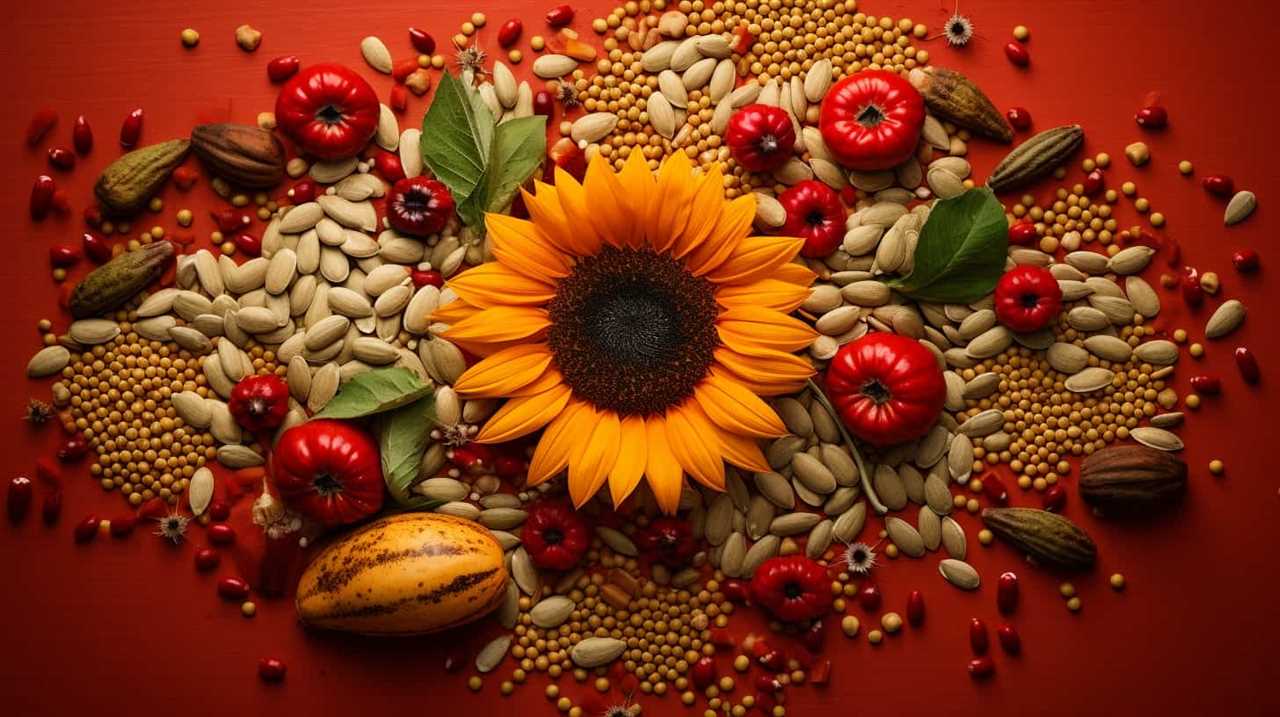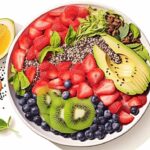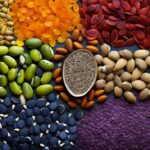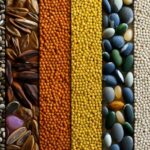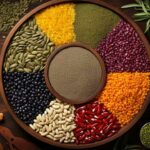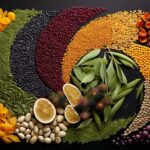We have exciting news for those following a gluten-free diet!
Did you know that chia seeds are not only delicious but also packed with protein? In fact, they are considered a complete protein source, providing all the essential amino acids our bodies need.
In this article, we will explore 8 fascinating facts about protein in gluten-free seeds, including the benefits of chia seeds, protein comparisons, and protein-rich recipes.
So, let’s dive in and discover how chia seeds can supercharge your protein intake!
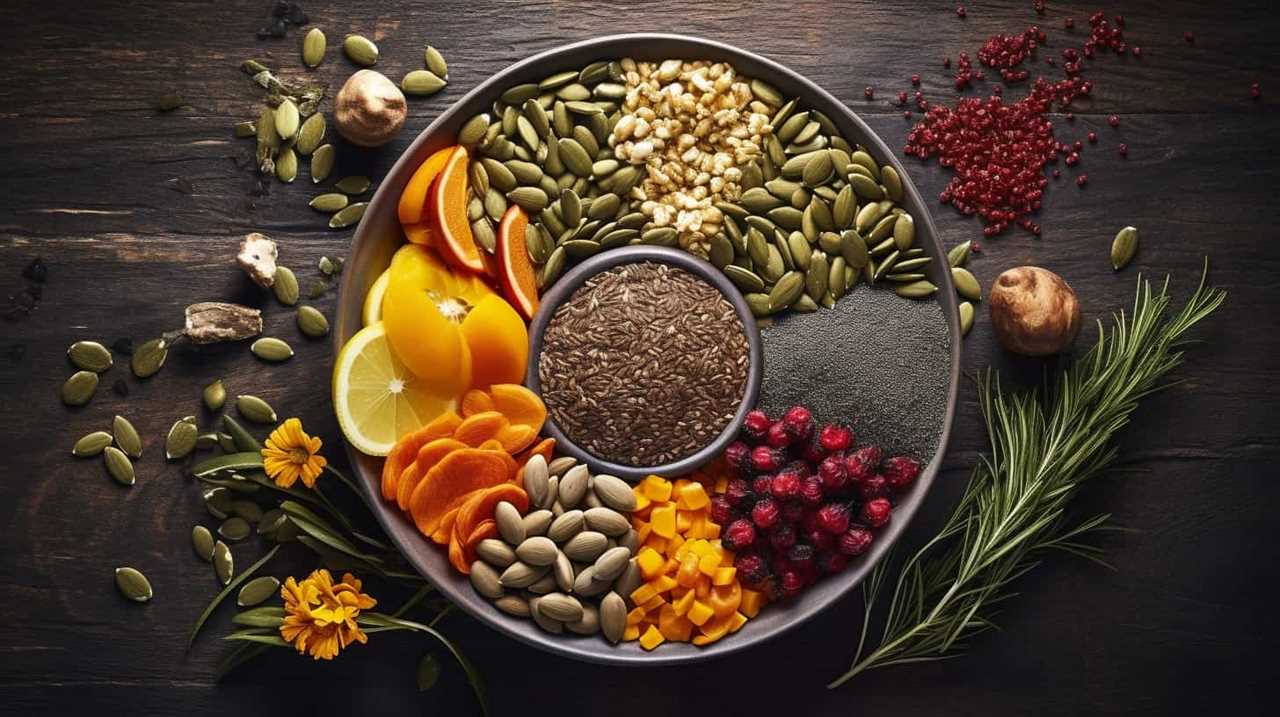
Key Takeaways
- Protein is crucial in a gluten-free diet, supporting overall health and providing essential nutrients.
- Chia seeds are an excellent plant-based source of protein, with one ounce providing around 4 grams of protein.
- Chia seeds contain all nine essential amino acids and are easily absorbed by the body.
- The protein in chia seeds supports muscle growth, tissue repair, and contributes to feelings of fullness, aiding in weight management.
Importance of Protein in Gluten-Free Diets
The importance of protein in gluten-free diets is evident in its role in supporting overall health and providing essential nutrients. When following a gluten-free diet, it’s crucial to ensure that you’re still getting enough protein to meet your body’s requirements.
Protein is essential for building and repairing tissues, supporting the immune system, and maintaining healthy hair, skin, and nails. Fortunately, there are many protein sources available for those following a gluten-free diet. Some excellent options include lean meats, poultry, fish, eggs, dairy products, legumes, nuts, and seeds.
These foods not only provide protein but also offer other essential nutrients like vitamins, minerals, and healthy fats. It’s important to consult with a healthcare professional or registered dietitian to determine your specific protein requirements and to ensure you’re meeting them while following a gluten-free diet.
Protein Content in Chia Seeds
Continuing the discussion on the importance of protein in gluten-free diets, let’s now explore the protein content in chia seeds. Chia seeds are a nutritional powerhouse, packed with essential nutrients including protein.
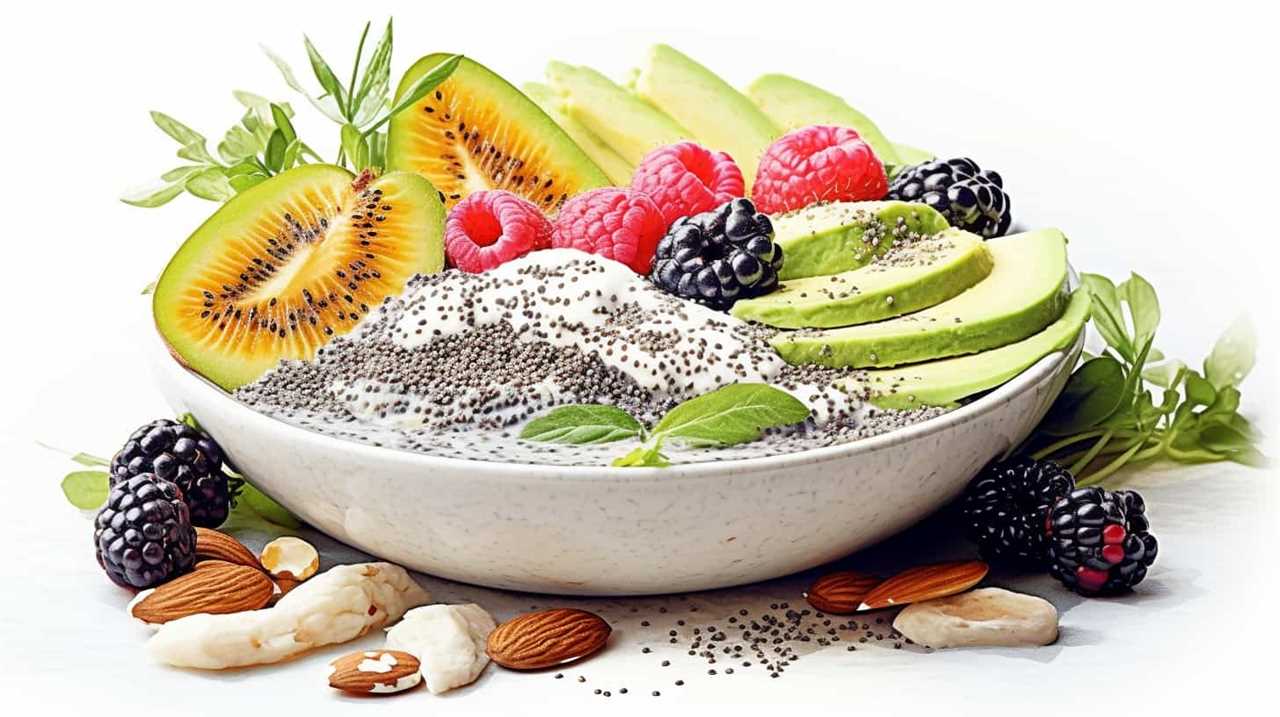
Here are some key points about the protein content in chia seeds:
- Chia seeds are an excellent plant-based source of protein, containing all nine essential amino acids.
- Just one ounce (28 grams) of chia seeds provides around 4 grams of protein, making it a great addition to a protein-rich diet.
- Chia seeds have a high protein absorption rate, meaning your body can efficiently utilize the protein it contains.
- The protein in chia seeds helps to support muscle growth, repair tissues, and maintain overall health.
Incorporating chia seeds into your gluten-free diet can be a great way to boost your protein intake while enjoying the numerous other nutritional benefits they offer.
Benefits of Chia Seeds for Protein Intake
When it comes to protein intake, chia seeds offer several benefits.
First, chia seeds are a great source of plant-based protein, containing about 4 grams per ounce.
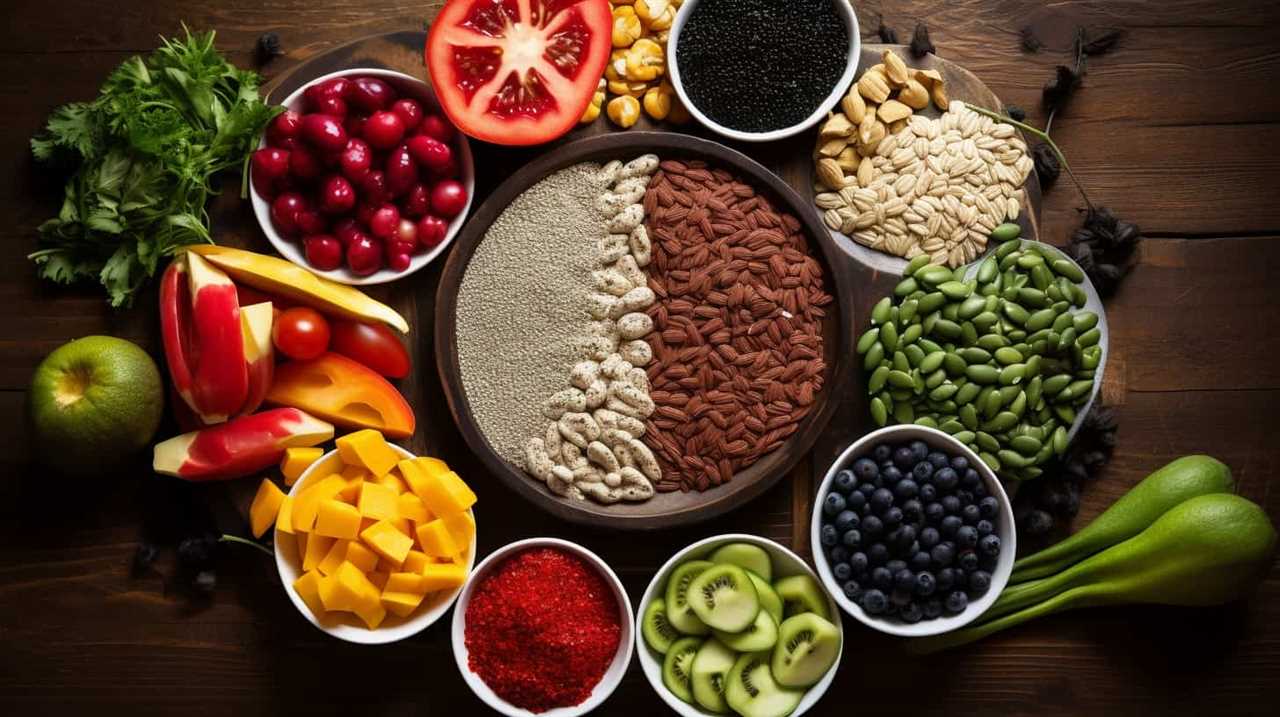
Second, chia seeds are a complete protein, meaning they contain all nine essential amino acids that our bodies need.
Lastly, chia seeds are easily absorbed by the body, allowing for maximum protein utilization.
Chia Seeds Protein Content
To explore the benefits of chia seeds for protein intake, let’s delve into their impressive protein content. Chia seeds are a nutritional powerhouse, packed with essential nutrients that support overall health and well-being. When it comes to protein, chia seeds are a great plant-based source.
Here are four key points to consider:

- High protein content: Chia seeds are an excellent source of protein, with about 4 grams of protein per 1-ounce serving.
- Complete protein: Chia seeds contain all nine essential amino acids, making them a complete source of protein.
- Muscle recovery and growth: Protein is essential for muscle repair and growth, making chia seeds a beneficial addition to a post-workout snack or meal.
- Satiety and weight management: Protein-rich foods like chia seeds can help promote feelings of fullness and aid in weight management.
Incorporating chia seeds into your diet can provide a significant protein boost and contribute to overall health and wellness.
Chia Seeds Amino Acids
4 essential amino acids are found in chia seeds, making them a valuable source of protein for our diet. These essential amino acids include isoleucine, leucine, lysine, and valine, which play crucial roles in protein synthesis and various physiological processes in our bodies.
Chia seeds are known for their high nutritional value, as they also contain other non-essential amino acids such as alanine, arginine, glutamic acid, and proline. These amino acids contribute to the overall protein content of chia seeds and support the growth, repair, and maintenance of our body tissues.
Incorporating chia seeds into our diet can provide us with a plant-based protein source that’s rich in essential amino acids.

Now, let’s delve into the next section to understand how our bodies absorb the protein from chia seeds.
Chia Seeds Protein Absorption
Chia seeds offer efficient protein absorption, making them an excellent choice for enhancing our protein intake. Here are some key points regarding the protein digestibility and bioavailability of chia seeds:
- Chia seeds have a high protein digestibility, meaning that our bodies can easily break down and absorb the protein they contain.
- The protein in chia seeds is considered to be of high quality, as it contains all the essential amino acids that our bodies can’t produce on their own.
- Chia seeds have a high bioavailability of protein, which means that a significant portion of the protein present in chia seeds can be utilized by our bodies.
- The protein in chia seeds can help support muscle growth, repair tissues, and contribute to overall health and well-being.
Chia Seeds as a Complete Protein Source
Chia seeds aren’t only a great source of protein, but they also provide a complete protein profile. This means that they contain all nine essential amino acids that our bodies can’t produce on their own.
Chia seeds are a nutritional powerhouse, packed with fiber, omega-3 fatty acids, and antioxidants, making them an excellent addition to a gluten-free diet.

Chia: Complete Protein Benefits
Exploring the benefits of chia seeds as a complete protein source, we discovered an impressive range of essential amino acids. Chia seeds aren’t only packed with protein, but they also offer numerous other nutritional benefits. Here are some key points about the benefits and nutritional value of chia seeds:
- Chia seeds are a complete protein source, meaning they contain all nine essential amino acids that our bodies need.
- They’re an excellent source of plant-based protein, making them a great choice for vegetarians and vegans.
- Chia seeds are rich in fiber, which can help promote digestive health and keep you feeling full for longer.
- They’re also high in omega-3 fatty acids, which have been linked to numerous health benefits, including reducing inflammation and improving heart health.
With their impressive nutritional profile, chia seeds truly are a nutritional powerhouse.
Now, let’s delve into the additional nutritional benefits they offer.
Chia: Nutritional Powerhouse
Why are chia seeds considered a nutritional powerhouse as a complete protein source?
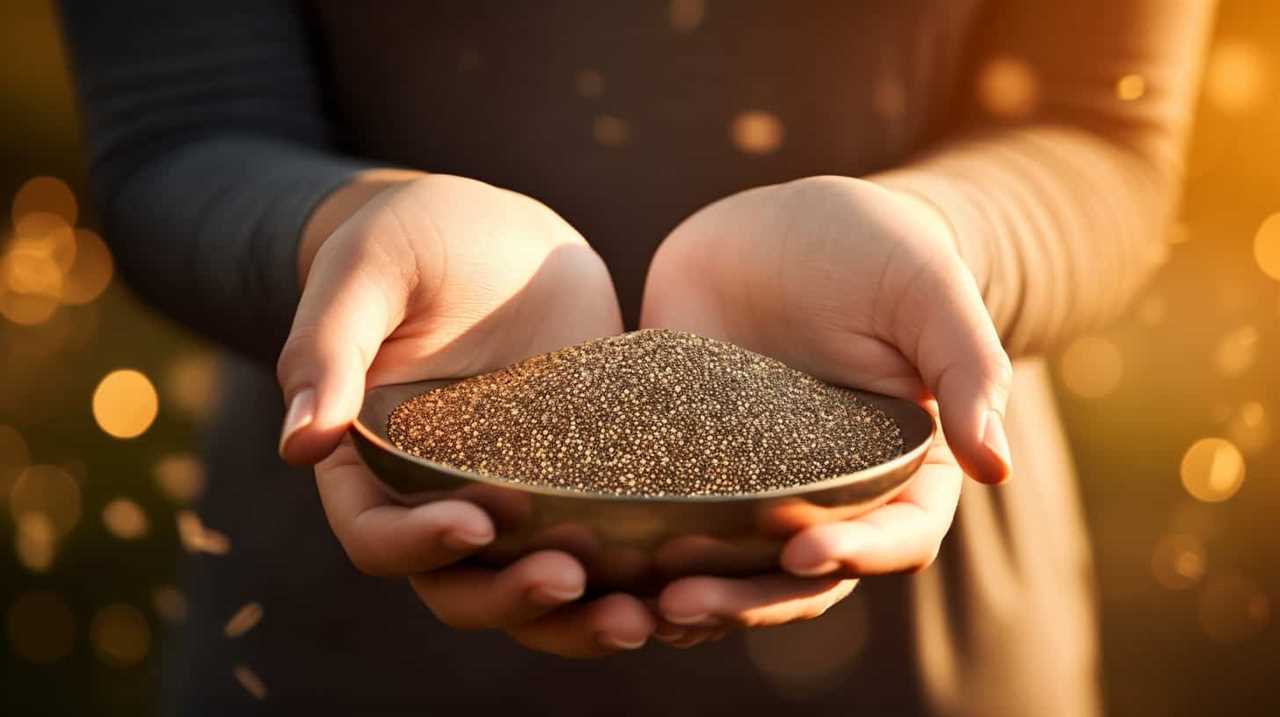
Chia seeds are packed with numerous health benefits and are a great addition to any diet. Not only are they a complete protein source, containing all nine essential amino acids, but they also provide a good amount of fiber, healthy fats, and essential minerals.
Chia seeds are known for their ability to absorb liquid and form a gel-like substance, which helps keep you feeling fuller for longer and aids in digestion. They can be easily incorporated into your meals and snacks, making them a versatile ingredient.
From chia pudding and smoothies to energy bars and baked goods, there are endless chia seed recipes to explore. Adding chia seeds to your diet can help support your overall health and well-being.
Protein Comparison: Chia Seeds Vs Other Gluten-Free Seeds
One important aspect to consider when comparing protein content in gluten-free seeds is the amount found in chia seeds compared to other gluten-free seeds. Chia seeds are known for being a great source of protein, but how do they compare to other seeds in terms of protein content? Here are some key points to consider:
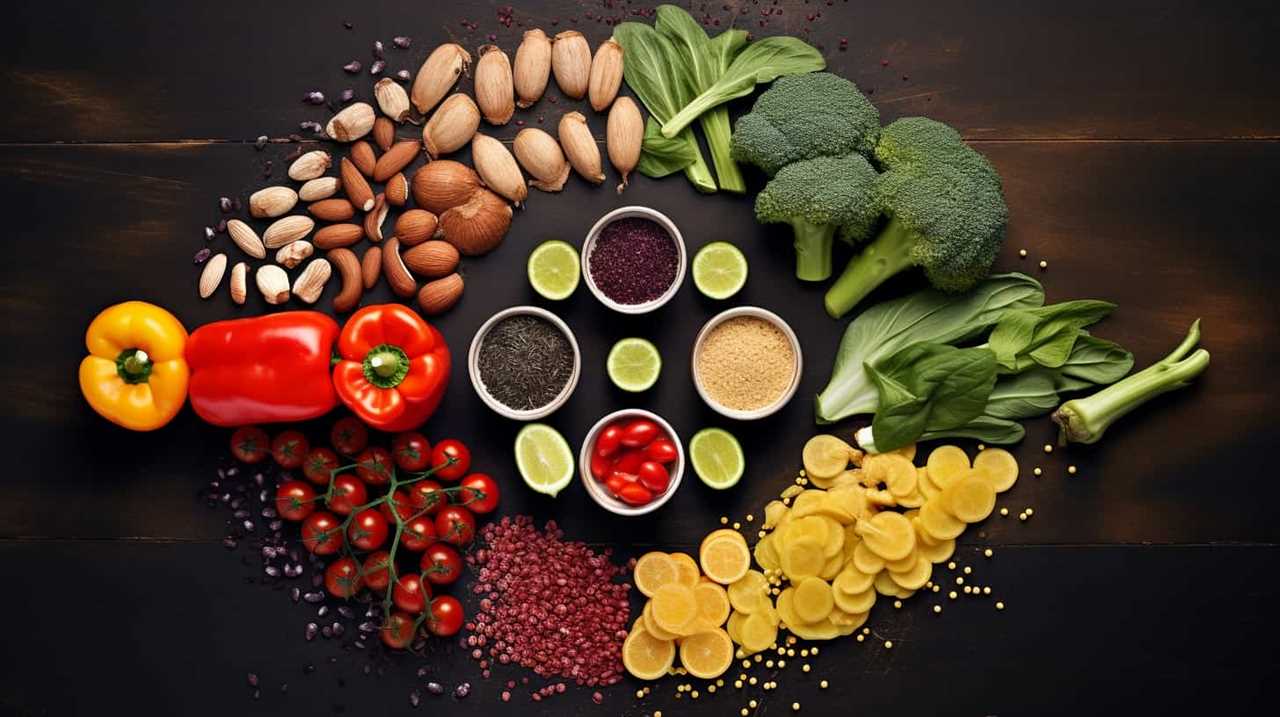
- Chia seeds have a higher protein content compared to many other gluten-free seeds.
- Chia seeds contain approximately 4.7 grams of protein per ounce, making them an excellent plant-based protein source.
- Other gluten-free seeds like flaxseeds, hemp seeds, and pumpkin seeds also provide a good amount of protein, ranging from 2 to 5 grams per ounce.
- It’s important to note that while chia seeds and other gluten-free seeds are rich in protein, they should be consumed as part of a balanced diet to ensure you’re getting a variety of nutrients.
Protein-Rich Recipes With Chia Seeds
To continue our discussion on protein content in gluten-free seeds, let’s explore some delicious and protein-rich recipes that incorporate chia seeds. Chia seeds are a fantastic addition to any meal, providing a great source of plant-based protein.
Here are two protein-packed recipes that feature chia seeds:
- Protein Packed Smoothie:
- Ingredients:
- 1 ripe banana
- 1 cup almond milk
- 1 tablespoon chia seeds
- 1 scoop of protein powder
- Handful of spinach
- Instructions:
- Blend all the ingredients together until smooth.
- Enjoy this nutritious and energizing smoothie as a quick breakfast or post-workout snack.
- Protein Rich Breakfast Bowl:
- Ingredients:
- 1/2 cup Greek yogurt
- 2 tablespoons chia seeds
- 1/4 cup mixed nuts and seeds
- 1 tablespoon honey or maple syrup
- Fresh fruits for topping (e.g., berries, sliced banana)
- Instructions:
- In a bowl, combine Greek yogurt, chia seeds, and honey or maple syrup.
- Top with mixed nuts and seeds, along with your favorite fresh fruits.
- Enjoy this protein-rich and filling breakfast bowl to start your day off right.
These recipes aren’t only packed with protein but also provide a great way to incorporate chia seeds into your diet. They’re quick, easy, and delicious options for those looking to add more protein to their breakfast.
How to Incorporate Chia Seeds Into a Gluten-Free Diet
Now let’s explore how we can incorporate chia seeds into a gluten-free diet. Chia seeds are versatile and can be easily included in various dishes to enhance their nutritional value. Here are a few ideas:
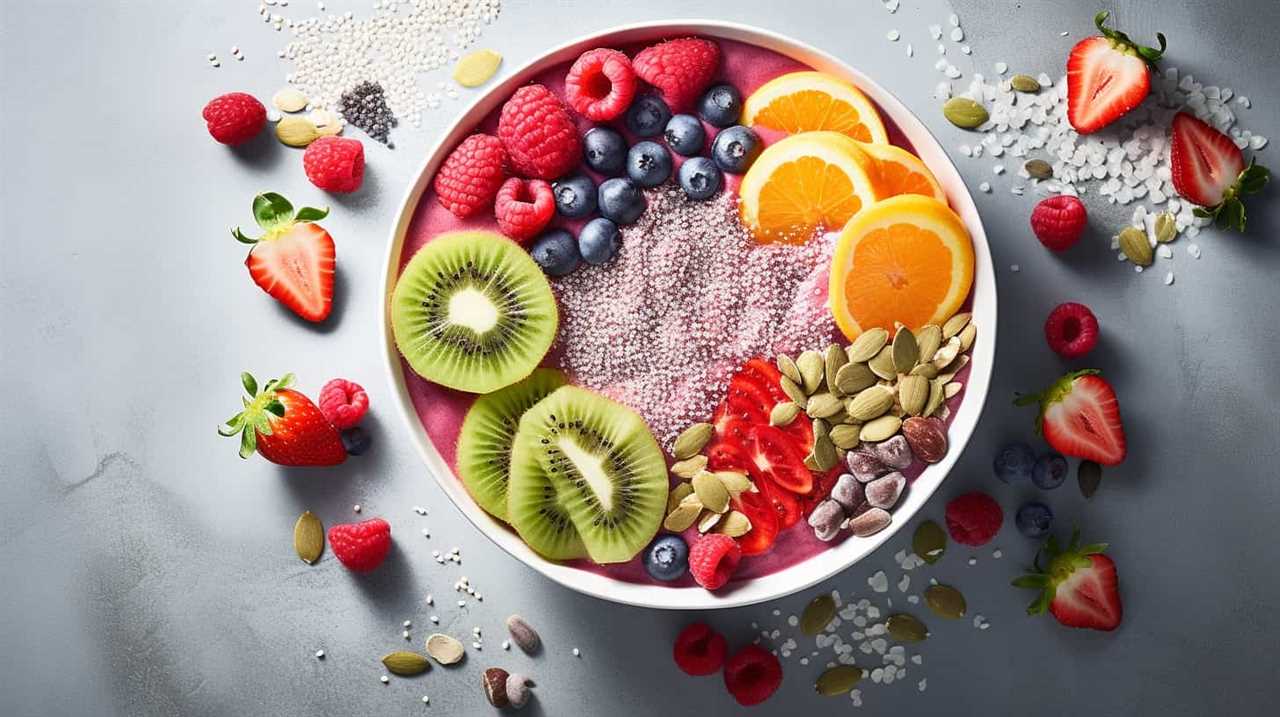
- Chia Seed Pudding: Whip up a delicious and nutritious chia seed pudding by mixing chia seeds with your choice of milk (such as almond or coconut milk), sweetener, and flavorings like vanilla or cocoa powder. Let it sit in the fridge overnight, and enjoy a creamy and satisfying gluten-free dessert or breakfast option.
- Smoothies: Add a tablespoon of chia seeds to your favorite gluten-free smoothie for an extra boost of fiber, protein, and omega-3 fatty acids. The chia seeds will also add a nice texture to your smoothie.
- Baked Goods: Incorporate chia seeds into your gluten-free baking recipes, such as muffins, bread, or cookies. They can be used as an egg substitute by mixing one tablespoon of chia seeds with three tablespoons of water, allowing it to sit for a few minutes until it forms a gel-like consistency.
- Salad Toppings: Sprinkle chia seeds on top of your gluten-free salads for added crunch and nutrition. They can also be used as a replacement for croutons or breaded toppings.
Incorporating chia seeds into a gluten-free diet is simple and can provide a range of health benefits. Experiment with different chia seed recipes to find your favorite ways to enjoy them.
Protein Supplements and Chia Seeds for Gluten-Free Diets
As we continue our exploration of incorporating chia seeds into a gluten-free diet, let’s delve into the topic of protein supplements and chia seeds. For individuals following a gluten-free diet, finding protein sources that are safe and nutritious can be a challenge. Luckily, chia seeds are an excellent option. Not only are they gluten-free, but they also provide a good amount of protein. In fact, chia seeds are considered a complete protein, as they contain all essential amino acids. However, if you’re looking for additional protein supplementation, there are several gluten-free protein options available. Here is a table showcasing three popular protein supplements that are gluten-free:
| Protein Supplement | Protein Content per Serving (grams) | Gluten-Free |
|---|---|---|
| Whey Protein | 24 | Yes |
| Pea Protein | 20 | Yes |
| Hemp Protein | 15 | Yes |
These protein supplements can be easily incorporated into your gluten-free diet, providing you with the necessary protein for optimal health and nutrition.
Frequently Asked Questions
Are Chia Seeds the Only Gluten-Free Seeds That Are High in Protein?
Yes, chia seeds are not the only gluten-free seeds that are high in protein. There are various alternative gluten-free protein sources such as hemp seeds, flax seeds, pumpkin seeds, and quinoa. These seeds offer similar benefits to chia seeds.

Can Chia Seeds Be Used as a Protein Supplement for Individuals on a Gluten-Free Diet?
Chia seeds can be a valuable protein supplement for vegans on a gluten-free diet. They offer numerous benefits for muscle recovery due to their high protein content.
How Much Protein Should Be Consumed Daily for Individuals on a Gluten-Free Diet?
We should consume an adequate amount of protein daily on a gluten-free diet. Incorporating protein in our diet is crucial for building and repairing tissues, promoting satiety, and supporting overall health.
Can Chia Seeds Be Used as a Protein Source for Athletes on a Gluten-Free Diet?
Chia seeds can be a beneficial protein source for athletes on a gluten-free diet. They offer numerous benefits for muscle recovery and are a great alternative to other gluten-free protein sources.
Are There Any Potential Risks or Side Effects Associated With Consuming Chia Seeds for Protein in a Gluten-Free Diet?
There may be potential risks or side effects associated with consuming chia seeds for protein in a gluten-free diet. However, chia seeds also offer numerous nutritional benefits for those following a gluten-free diet.

Conclusion
In conclusion, incorporating chia seeds into a gluten-free diet can be a beneficial way to increase protein intake.
Chia seeds aren’t only rich in protein, but they also offer numerous health benefits. They’re a complete protein source, meaning they contain all essential amino acids.
Additionally, chia seeds can be easily incorporated into various recipes and can even be used as a protein supplement.
Overall, chia seeds are a great addition to a gluten-free diet for those looking to boost their protein consumption.

